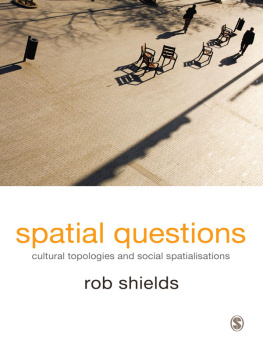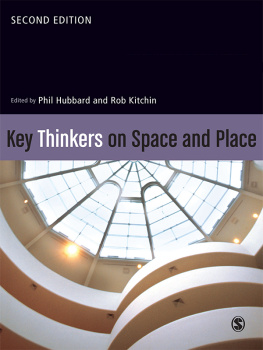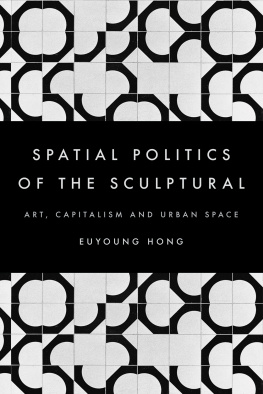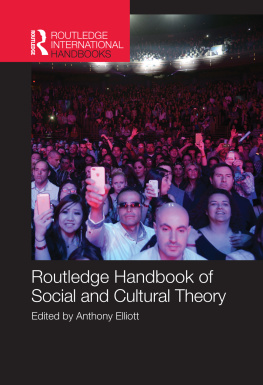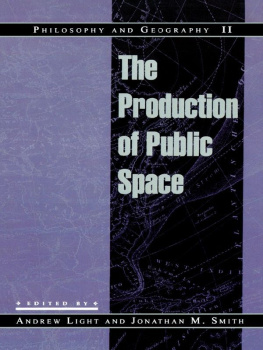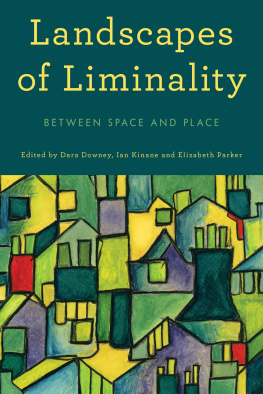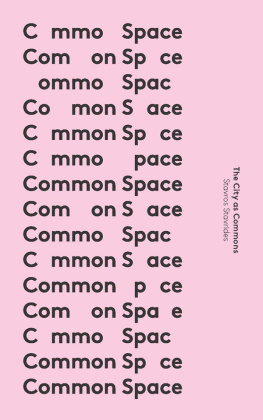spatial questions
To Sophie and Bohdana
spatial questions
cultural topologies and social spatialisations
rob shields


SAGE Publications Ltd
1 Olivers Yard
55 City Road
London EC1Y 1SP
SAGE Publications Inc.
2455 Teller Road
Thousand Oaks, California 91320
SAGE Publications India Pvt Ltd
B 1/I 1 Mohan Cooperative Industrial Area
Mathura Road
New Delhi 110 044
SAGE Publications Asia-Pacific Pte Ltd
3 Church Street
#10-04 Samsung Hub
Singapore 049483
Editor: Chris Rojek
Editorial assistant: Martine Jonsrud
Production editor: Katherine Haw
Copyeditor: Rosemary Campbell
Marketing manager: Michael Ainsley
Cover design: Wendy Scott
Typeset by: C&M Digitals (P) Ltd, Chennai, India Printed by the Replika Press Pvt. Ltd, India
Rob Shields 2013
First published 2013
Apart from any fair dealing for the purposes of research or private study, or criticism or review, as permitted under the Copyright, Designs and Patents Act, 1988, this publication may be reproduced, stored or transmitted in any form, or by any means, only with the prior permission in writing of the publishers, or in the case of reprographic reproduction, in accordance with the terms of licences issued by the Copyright Licensing Agency. Enquiries concerning reproduction outside those terms should be sent to the publishers.
Library of Congress Control Number: 2012934972
British Library Cataloguing in Publication data
A catalogue record for this book is available from the British Library
ISBN 978-1-84860-664-7
ISBN 978-1-84860-665-4 (pbk)
table of contents
list of illustrations
about the author
Dr Rob Shields is Henry Marshall Tory Chair and Director of the Faculty of Extensions City-Region Studies Centre and teaches in the Departments of Sociology and of Art and Design at the University of Alberta. Before being awarded the Tory Chair, he was Professor of Sociology and past Director of the Institute of Interdisciplinary Studies at Carleton University.
His focus has been urban cultural studies, particularly the social use and meanings of Places on the Margin, urban spaces and regions, including tourist destinations and place identities. In co-edited collections such as Rereading Jean-Franois Lyotard, and Demystifying Deleuze and in texts such as Lefebvre, Love and Struggle, Shields considers changing spatialisations. This intellectual project has been extended through a peer-reviewed journal, Space and Culture, Curb planning magazine and many talks on the city, the Strip-Appeal of malls and other Ecologies of Affect, and the importance of intangibles and The Virtual to everyday life.
preface and acknowledgements
This book is a work of thresholds, edges and folds: a topology in many senses it explores spatial distinctions and boundaries established by markers such as a doorway, as well as less tangible distinctions such as near and far or cultural divisions between social fields. It marks a threshold of new research that shifts from space as a constitutive dimension and spatialisation of social life and personal identities to understanding competing and contested time-space milieux which are elaborated by social interactions, texts and institutional relationships. This shift from questions of social spatialisation to time-space topologies structures the sequence of chapters in this book.
We begin by shifting from the discourse of space to social spatialisation from the beginning. For a detailed discussion of social spatialisation, the reader is refered to Places on the Margin (1991), with its case histories of how social action and place-images plays out as a nuanced geography of interlinked places and regions. Here, social spatialisation or just spatialisation is used to capture the sense in which places are cast as places-for-this or places-for-that. Spatialisation in French and English popular usage has meant making spatial. In , social spatialisation redefines space as a problematic term by locating its partiality and identifying the cultural role that it plays by constructing a crucible and arena for the play of capital, art and technology. It seeks to not only translate but move beyond Lefebvres Marxist-Hegelian analysis by stressing its Leibnizean, Nietzschean and even structural qualities and drawing on Foucault and Deleuzes equally Nietzschean engagements with cultural and psychological structures of power. Their debt to twentieth-century French thought Durkheim, Cassirer, Bachelard and Canguilhem is well established despite their critiques and denials. However, spatialisation takes on a distinct meaning in my usage given that Foucault and Deleuze tend to use the term spatialisation in its French sense as localisation, placing.
A Glossary is appended after the last chapter to provide a ready reference to the terminology used in this book. Terms such as the virtual, material, actual, real, ideal, possible, abstract and probably are ontological aspects of events and objects drawn from The Virtual (Shields, 2003, 2006b). They stand in the relation to each other described by Prousts definition of memory, developed in part by Deleuze, as virtual: real but not actual, ideal but not abstract.of fictional place-images as the character of a place or the actualisation of that quality in a built environment such as a tourist attraction. Although none occur purely, for example a virtuality in isolation from material object or vice versa, the terms can be diagrammed as a four-part ontology:

Rather than either-or, this table is a synopsis of a set of modalities of existence that co-occur and provide the stations of a continuously changing reality, where objects appear of use at hand in their capacity to occupy all of these positions, that is, to be simultaneously actually one thing but as if something else, possibly effective for other uses and metaphoric of others. Table 1.1 is thus marked by continuous movement between its categories: realisation of the possible, actualisation of the ideal, virtualisation of the actual, and so on, and also illegitimate transformations such as from the abstract to the concrete, described as the miraculous in everyday speech (see Shields, 2003). Syncretic phenomena that are undecidable, hovering on the boundary between categories are also of great interest.
Since its presentation in Places on the Margin, spatialisation seems to have provided a tool-kit for geographical analyses of a much broader set of phenomena (Shields, 2006a; see for example, the usage in Hall, 2003: 151). The term has been disseminated as a keyword across human geography in particular. Contributors to a recent reference book use the term over a hundred times in 350 pages to profile Key Thinkers on Space and Place (Hubbard et al., 2004). Historically, one might ask whether or not it constitutes a paradigm shift in geographical thought? The argument pursued in this book goes further. Do questions of spatialisation in turn lead to questions of time, history and memory that demand a less genealogical, more topological approach to space-time? The affective quality of hoped-for futures and nostalgic pasts has been the topic of previous collective research by the Space and Culture Research Group at the University of Alberta, culminating in the edited book-work
Next page
